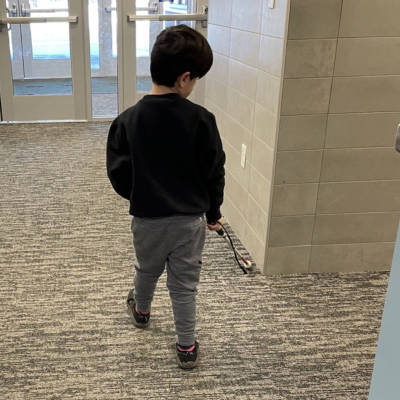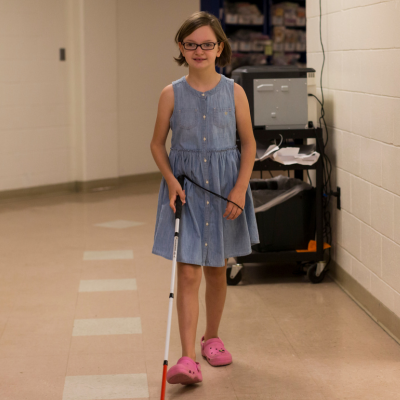Types of Assessments and Evaluations
Early childhood providers, school personnel or family members may refer a child with suspected visual impairment for initial evaluation. In conducting a comprehensive evaluation, a variety of evaluation tools and strategies can gather relevant functional, developmental, and academic information about the child that may assist in determining whether that child is eligible for special education and to determine their educational and functional needs.
Functional Vision Evaluation
A Functional Vision Evaluation (FVE) incorporates direct visual testing of the child; observations of his/her visual behaviors in the learning environment, under different lighting conditions, in common spaces and outside; and interviews with parents and school personnel most familiar with the child.
While the medical eye report often clinically documents the extent of vision and the behavior of the eyes, the FVE formally and informally assesses the way that the child actually uses the residual vision they have, the implications of visual deficiencies for learning and functional skills, and the coping or compensatory behaviors that the child with visual impairment employs.
Conducting an FVE when a visual impairment is diagnosed or suspected, and every three years thereafter at a minimum, is required by federal law. A FVE should be conducted by a certified TVI prior to other evaluations so that visual factors can be incorporated into the design and administration of any additional testing. The goal is to ensure that other test results accurately reflect the child’s aptitude and not the impact of a visual impairment.
Learning Media Assessment
The Learning Media Evaluation (LME) extends the results of the FVE and assesses the efficiency with which the learner with visual impairment gathers information from various sensory channels (visual, auditory , tactile, etc.), the formats of general instructional materials and methods needed, and the types of educational technology (low-tech and high-tech) that will enable the learner with visual impairment to access the learning environment.
For educational purposes, the LME should almost universally be completed at the same time as the FVE.
In addition, an LME is the only evaluation that can answer the question about the need for instruction in braille. According to federal law, “In the case of a learner who is blind or visually impaired, provide for instruction in braille and the use of braille unless the IEP team determines, after an evaluation of the learner’s reading and writing skills, needs, and appropriate reading and writing media (including an evaluation of the learner’s future needs for instruction in braille or the use of braille), that instruction in braille or the use of braille is not appropriate for the learner.” (34 CFR §300.324) In plain English, this means that the IEP team has to prove that, at that particular point in time, a learner with visual impairment does not need braille.
A Learning Media Evaluation, conducted by a TVI as part of a comprehensive evaluation, is designed to help make that determination, and to determine how the learner with visual impairment will be able to efficiently access the curriculum, if not through braille.
Assessment for Cortical Visual Impairment
Because CVI interferes with the brain’s ability to process visual information, even in cases where the eyes function normally, the indicators may be different from, but as important as, indicators of an Ocular Visual Impairment (OVI). By definition CVI involves some dysfunction in one or more areas of the brain. More than 40% of the brain is involved in visual processing in some capacity, and the visual pathways that are affected will correspond with certain visual and motor behaviors.
In cases of premature birth, brain injury, oxygen deprivation, or when multiple disabilities are present or suspected, the FVE process should consider implications that stem from the potential impact of a neurologically-based visual impairment. CVI is now the most prevalent and fastest growing cause of visual impairment in children.
CVI falls in a range from mild to severe. The clues that could indicate CVI include visual behaviors such as delayed attention to a visual stimulus, prolonged gazing at a light source, greater attention to objects that are color saturated, particularly bright red or bright yellow, for instance. Some visual behaviors, such as the lack of a blink reflex to protect the eyes from potential injury, may pose a safety concern. Other behaviors, such as lack of eye contact when listening to someone speak, can be misinterpreted as disinterest. Still others indicate a disconnect between vision and body movements, such as a child who looks away before reaching for something.
Orientation and Mobility Evaluation
An Orientation and Mobility Evaluation conducted by a Certified Orientation and Mobility (O&M) specialist is essential for learners who are blind and visually impaired to determine their ability to move safely, independently, and efficiently through their environment. Uneven terrain, stairs, elevators, escalators, new environments, parking lots and street crossings can all pose significant safety hazards for children and adolescents untrained in ways to safely navigate these spaces.
Taken separately, orientation refers to the use of sensory information to establish and maintain one’s position in the environment, and mobility refers to the capacity, readiness, and ability to move safely. Depending on age and disability, the environments for evaluation should include community settings; many learners with visual impairment are quite dependent on families and caregivers when younger. As they age and become more independent, safety and experience in navigating unfamiliar settings becomes crucial.
Assistive (Educational) Technology Evaluation
Assessing the needs for technology for a child with visual impairment should be done only after the FVE and LME, so that functional vision and learning channels are well understood, thus allowing technology to be matched to the learner’s preferred learning channels.
The purpose of the evaluation for Educational Technology — often referred to as Assistive Technology (or AT) — is to document and/or determine if the present technology being used is appropriate and used correctly, as well as determine future needs for technology for the child to access the curriculum and complete tasks in the learning environment. The use of multiple tools and methods, including allowing the child to trial appropriate technology, allows the evaluation to be individualized.





